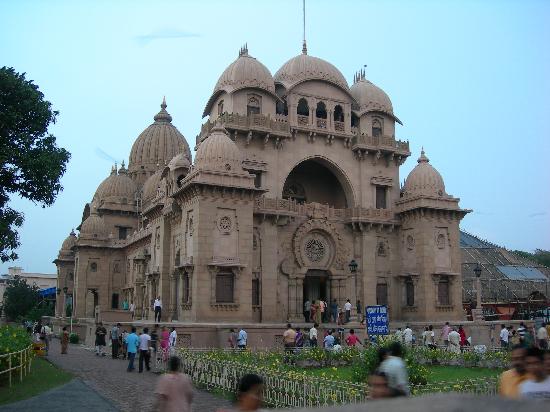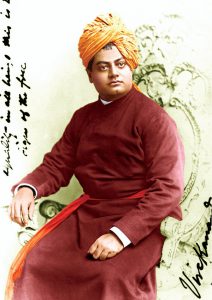 Ramakrishna Mission Vivekananda Educational and Research Institute (RKMVERI) is established, administered and run by Ramakrishna Mission (sponsoring society of the University), a registered society started by Swami Vivekananda in 1897. Ramakrishna Mission is a well-known and reputed non-governmental organization (NGO) serving the society in India and abroad irrespective of caste, colour, creed, religion, nationality, gender, regional bias etc., through its vast network of nearly 200 branch-centres in the fields of education, cultural and spiritual activities, health, relief and rehabilitation, rural and tribal development, publications, teaching and preaching, and a large number of allied areas all of which are for the all-round development of the individual and the society as a whole. Based on the ideology bequeathed by Swami Vivekananda, namely, ‘selfless service is the real worship of God in man’, ‘for one’s own liberation and for the welfare of the world’, Ramakrishna Mission has been silently serving the society since its inception at the turn of the twentieth century and is now well known as an established and accepted charitable, philanthropic, non-profit, non-governmental organization started by Swami Vivekananda.
Ramakrishna Mission Vivekananda Educational and Research Institute (RKMVERI) is established, administered and run by Ramakrishna Mission (sponsoring society of the University), a registered society started by Swami Vivekananda in 1897. Ramakrishna Mission is a well-known and reputed non-governmental organization (NGO) serving the society in India and abroad irrespective of caste, colour, creed, religion, nationality, gender, regional bias etc., through its vast network of nearly 200 branch-centres in the fields of education, cultural and spiritual activities, health, relief and rehabilitation, rural and tribal development, publications, teaching and preaching, and a large number of allied areas all of which are for the all-round development of the individual and the society as a whole. Based on the ideology bequeathed by Swami Vivekananda, namely, ‘selfless service is the real worship of God in man’, ‘for one’s own liberation and for the welfare of the world’, Ramakrishna Mission has been silently serving the society since its inception at the turn of the twentieth century and is now well known as an established and accepted charitable, philanthropic, non-profit, non-governmental organization started by Swami Vivekananda.

About the Ramakrishna Math and Ramakrishna Mission
The Ramakrishna Math and Ramakrishna Mission are twin organizations which form the core of a worldwide spiritual movement known as the Ramakrishna Movement or the Vedanta Movement. Headquartered at Belur Math on the bank of river Ganga in West Bengal, the movement aims at the harmony of religions, of the East and the West and of the ancient and the modern, as also at the all-round development of human faculties, social equality, peace, and above all, spiritual fulfillment for all of humanity without any distinctions of creed, caste, race or nationality.
Ramakrishna Math is an Order of sannyasins having Sri Ramakrishna (1836-1886), regarded as the prophet of the modern age, as the ideal. Ramakrishna Mission is a registered society engaged in the service of mankind in the spirit of ‘service of God in man’. It was founded by Sri Ramakrishna’s chief disciple, Swami Vivekananda (1863-1902), who is regarded as one of the main moulders of the modern world.
Ramakrishna Math was registered as a Trust in 1901 by Swami Vivekananda himself. Although the Ramakrishna Mission (originally called The Ramakrishna Mission Association) was started in 1897 by Swami Vivekananda with monastic and lay disciples of Sri Ramakrishna to actualize in light of Sri Ramakrishna’s realization the Vedantic teaching that all beings are veritable manifestations of the divine, the Ramakrishna Mission was formally registered in 1909 under the Registration of Societies Act XXI of 1860.
Vision
 It will be a great centre of tolerance and universal acceptance, of grand harmony of all religions, creeds and faiths, sending forth the shining message of goodwill, peace and harmony taking the whole universe to liberation.
It will be a great centre of tolerance and universal acceptance, of grand harmony of all religions, creeds and faiths, sending forth the shining message of goodwill, peace and harmony taking the whole universe to liberation.
The vision and mission of Ramakrishna Math and Ramakrishna Mission is best described in the words of its great founder Swami Vivekananda —
“My ideal indeed can be put into few words and that is: to preach unto mankind their divinity and how to make it manifest in every movement in life”.
तन्नो हंस: प्रचोदयात् (Tanno hamsah prachodayat), meaning, “May the Paramatman, Supreme Self [symbolized by] the Swan (hamsa), awaken our [higher] understanding.”
“It [Belur Math] will be a centre in which will be recognized and practiced a grand harmony of all creeds and faiths, as exemplified in the life of Sri Ramakrishna and only ideas of religion in its universal aspect will be preached. From this centre of universal toleration will go forth the shining message of goodwill and peace and harmony to deluge the whole world… This math shall become a great centre of learning and spiritual practices… The highest principles and ideals of religion have not only to be studied and comprehended but brought into the practical field of life… The spiritual force coming from here will permeate the whole world, turning the currents of men’s activities into new channels. From here will be disseminated ideals harmonizing jnana, bhakti, karma and yoga… There should be first annadana, or the giving of food and other necessities of physical life; next vidyadana or imparting of intellectual knowledge; and last of all jnanadana or conferring of spiritual knowledge. The harmonizing of three aspects that conduce to the making of man, must be the sole duty of the Math… We shall make this Math a great centre of harmony. Sri Ramakrishna is the visible embodiment of the perfect harmony of all ideals… We must see to it that people of all sects and creeds, from the brahmana down to the chandala, will find on coming here their respective ideas manifested. Granted that by realizing the Atman in meditation you attain mukti (liberation) but what is that to the world. We have to take the whole universe with us to mukti. Then only you will be established in the eternal truth. In that state you will be speechless, carried beyond yourself, by seeing your own Self in every being that breathes, and in every atom of the universe. When you realize this you cannot live in this world without treating everyone with exceeding love and compassion. This indeed is practical Vedanta.”
Mission
For one’s own liberation and welfare of the world.
This is the aphoristic dictum given by Swami Vivekananda to actualize the above vision, which is expressed in Sanskrit as, आत्मनो मोक्षार्थं जगद्धिताय च (atmano mokshartham jagaddhitaya cha).
Core Principles:
The Ramakrishna Mission is based upon the following two fundamental principles as taught by Swami Vivekananda based upon the life and realisations of his master Sri Ramakrishna:
- The potential divinity of all beings.
- The oneness of existence (the solidarity of the universe).
These two are the core principles of the Ramakrishna Math and Ramakrishna Mission organization.
Implied from the above core principles are the following:
- Principle of Freedom or liberation
- Synthesis of the four yogas — jnanayoga, bhaktiyoga, karmayoga and rajayoga.
- Harmony of religions
- Harmony of secular and sacred, or human and divine
Freedom or liberation was the watchword of Swami Vivekananda — liberation from ignorance, narrowness, selfishness, poverty, superstition, squalor, etc. This liberation is both individual and collective, resulting in individual and universal upliftment. Swami Vivekananda realised the unity of the individual and the collective through a vision he had in Almora in the Himalayas — the oneness of the microcosm (individual, vyashti) and macrocosm (collective, samashti).
The practical implementation of the motto he gave the Ramakrishna Mission, namely, आत्मनो मोक्षार्थं जगद्धिताय च (Atmano Mokshartham Jagaddhitaya Cha), meaning “for one’s own liberation and for the welfare of the world” is embodied in an aphoristic principle given by his Master Sri Ramakrishna: शिव ज्ञाने जीव सेव (Shiva jnane jiva seva), that is, “service of man is worship of God” or “service of God in man”. This is the guiding philosophy for all the philanthropic activities of the Ramakrishna Mission. Translated into secular parlance, this means that each human being has the potential for the highest excellence and service consists in trying to remove the obstacles to the realization and manifestation of this potential.